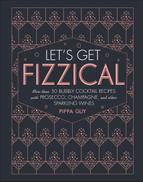FIZZ KNOW-HOW
TO MAKE the best cocktails, you need to know exactly how to handle your fizz. Plus, having a few fun facts up your sleeve is a great way to amuse your guests while you make the drinks. It’s time to brush up on your bubbly knowledge, become a fizz whiz, and put the pro in Prosecco.
WHAT’S the best TEMPERATURE to STORE BUBBLY?
The general consensus is that most sparkling wines taste better when chilled, so your fridge should do the trick. Vintage Champagne is an exception—it is best stored in a cool room at 50–55°F (10–13°C).
HOW do you OPEN BUBBLY SAFELY?
Be careful when opening fizz! Open the wire cage and, keeping your hand over the cork, twist the bottle to release. Don’t twist the cork, and never open in the direction of another person or a breakable object!
How MANY GRAPES GO INTO a BOTTLE of BUBBLY?
It takes approximately 600–800 grapes to make a single bottle of sparkling wine. When you think about the time and labor that goes into producing the fruit, it’s no wonder a bottle of bubbly can get pricey!
How MUCH PRESSURE does FIZZ CREATE?
The pressure in a bottle of Champagne is about two to three times the pressure in the tires of a car! This means fizz needs extra-thick bottles and corks to prevent it from exploding.
CAN I KEEP it FIZZY with a SPOON?
Sorry to burst your bubble, but this is an old wives’ tale. Sticking a spoon in the top of your bottle of bubbly won’t make it last any longer. Seal it with a Champagne stopper to retain the fizz.
HOW LONG can I KEEP an OPEN BOTTLE?
Once opened, Prosecco and Cava should be consumed within 1–3 days. Champagne lasts a little longer—around 3–5 days. Your bottle of bubbly will be at its best on the day of opening.
WHY do we SERVE FIZZ in CHAMPAGNE FLUTES?
Bubbly wines lose carbonation faster with a large surface area, so they are best served in tall, thin flutes. The long stem is designed to keep your hands off the main glass, so you don’t warm up the drink with body heat.
THE MOST confusing fizz jargon is the terminology around the levels of sweetness. When Champagne was first made, it was sweetened with large amounts of sugar. Over time, a desire for dryer (less sweet) styles developed, and winemakers started adding less dosage (sugar). These wines were named “demi-sec” or “sec,” meaning half-dry or dry. The demand for even drier wines increased, so they had to invent new terms that meant “drier than dry.” This is how the word “brut” was born.
TO PUT IT SIMPLY, THE STYLES TRANSLATE AS BELOW:
• BRUT NATURE: Completely dry, with zero added sugar
• EXTRA BRUT: Extremely dry
• BRUT: Very dry; the most common style
• EXTRA DRY: Off-dry
• SEC: Slightly sweet
• DEMI-SEC: Sweet
• DOUX: The sweetest style of sparkling wine
